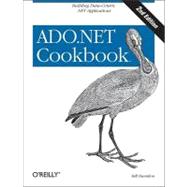
What is included with this book?
Bill Hamilton is a technology and management consultant who specializes in assessing business objectives and company processes and designing and restructuring technology strategy and enterprise architecture. Bill has been designing and implementing enterprise solutions using both SQL Server and Oracle for over a decade. Bill is the author of other O'Reilly titles including the highly praised Programming SQL Server 2005 and ADO.NET Cookbook, and he also writes for the Microsoft Developer Network. You can email Bill at bill.hamilton@element14.com.
| Second Edition | |
| Preface | |
| What's New in the Second Edition | |
| Who This Book Is For | |
| What You Need to Use This Book | |
| How This Book Is Organized | |
| What Was Left Out | |
| Conventions Used in This Book | |
| About the Code | |
| Using Code Examples | |
| Comments and Questions | |
| Safari“ Books Online | |
| Acknowledgments | |
| Connecting to Data | |
| Introduction | |
| Storing Connection Strings | |
| Building a Connection String | |
| Connecting to SQL Server | |
| Connecting to a Named Instance of SQL Server | |
| Connecting to SQL Server Using an IP Address | |
| Connecting to SQL Server Using Integrated Security from ASP.NET | |
| Connecting to an Oracle Database | |
| Connecting to an OLE DB Data Source | |
| Connecting to an ODBC Data Source | |
| Connecting to a Microsoft Access Database | |
| Connecting to a Password-Protected Microsoft Access Database | |
| Connecting to a Microsoft Access Database from ASP.NET | |
| Connecting to a Microsoft Excel Workbook | |
| Connecting to a Text File | |
| Changing the Database for an Open Connection | |
| Setting Connection Pooling Options | |
| Taking Advantage of Connection Pooling | |
| Using Transactions with Pooled Connections | |
| Displaying a Connection Property Dialog Box | |
| Displaying the Data Link Properties Dialog Box | |
| Monitoring Connections | |
| Working with Disconnected Data Objects | |
| Introduction | |
| Creating a DataColumn and Adding It to a DataTable | |
| Creating a DataTable and Adding It to a DataSet | |
| Mapping Table and Column Names Between a Data Source and DataSet | |
| Mapping .NET Data Provider Data Types to .NET Framework Data Types | |
| Adding a Calculated Column to a DataTable | |
| Creating a Unique Constraint | |
| Creating Single- and Multi-Column Primary Keys | |
| Creating an Autoincrementing Primary Key | |
| Creating a Foreign Key Constraint | |
| Creating a Data Relation | |
| Building a DataSet Programmatically | |
| Adding a Column to a Child DataTable That Displays Data from the Parent Table | |
| Adding a Column to a Parent DataTable That Aggregates a Child Table's Column Values | |
| Converting Between a DataTable and a DataRow Array | |
| Accessing Data Values in a DataRow Array | |
| Creating a Strongly Typed DataSet | |
| Controlling the Names Used in a Strongly Typed DataSet | |
| Replacing Null Values in a Strongly Typed DataSet | |
| Querying and Retrieving Data | |
| Introduction | |
| Executing a Query That Does Not Return a Result Set | |
| Executing a Query That Returns a Single Value | |
| Retrieving a Result Set Stream Using a DataReader | |
| Accessing Data Values in a DataReader | |
| Retrieving a Result Set Using a DataTable or a DataSet | |
| Table of Contents provided by Publisher. All Rights Reserved. |
The New copy of this book will include any supplemental materials advertised. Please check the title of the book to determine if it should include any access cards, study guides, lab manuals, CDs, etc.
The Used, Rental and eBook copies of this book are not guaranteed to include any supplemental materials. Typically, only the book itself is included. This is true even if the title states it includes any access cards, study guides, lab manuals, CDs, etc.